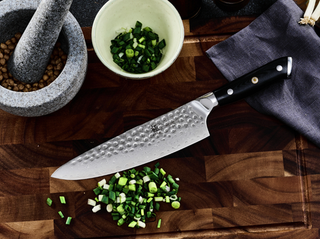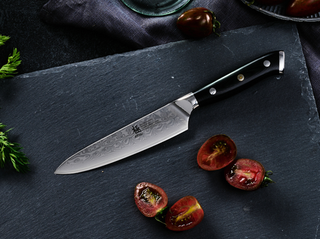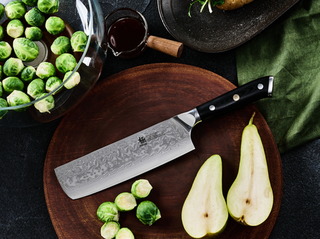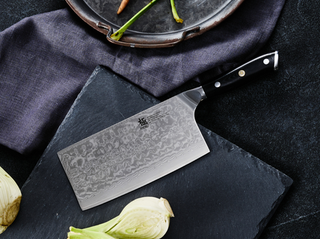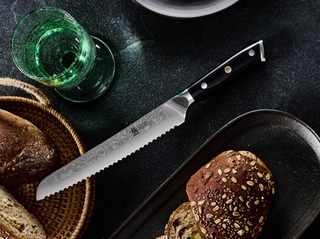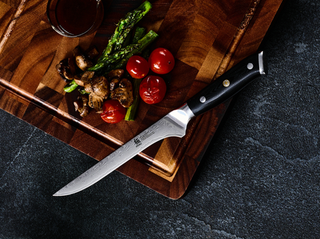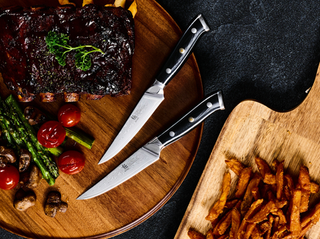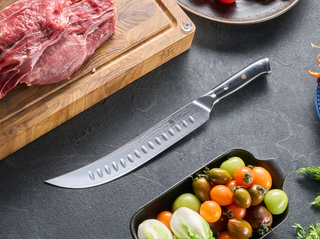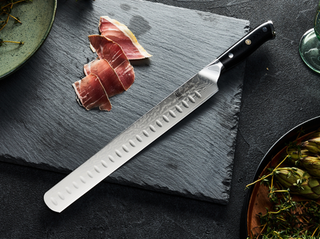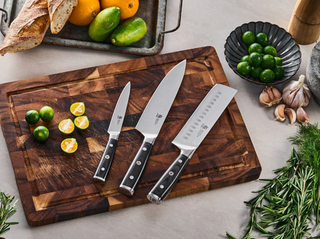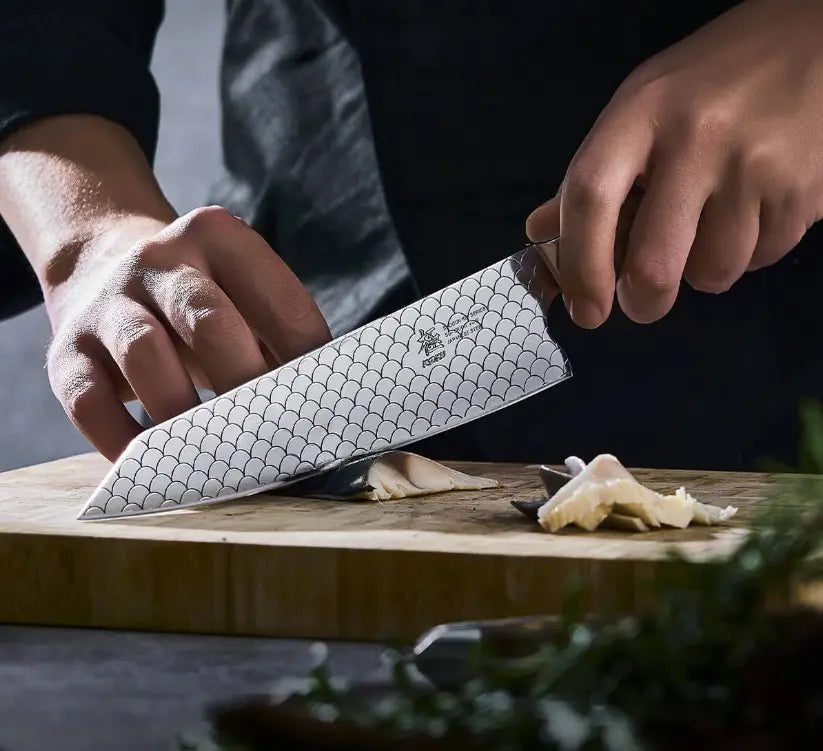An ambitious chef’s journey begins slowly but requires swift action—with a knife. The latter is the perfect instrument for station cooks to impress their head chef. But sadly, not many get this golden opportunity for a lifetime. The reasons are the wrong tools, decisions, and miscalculations. In simple terms, we’re talking about the silver collection of knives. Astonishingly, a single blade can overturn the verdict in your favor. We're talking about the Damascus blade, which is quite popular in Japan—for its vivid styles, variations, and versatility.

Have one in your pocket; it comes in handy—knowing the unexpected uses for your Japanese knife is a plus. These blades are more than just handheld steel structures wedged in a case-hardened handle. They are practically useful and adaptable—like a Swiss knife.
Kiritsuke Knives VG10 Damascus Steel—that Cuts through to Stand Out
This blade is the bestseller Kyoku has to offer to its valued customers. First, its razorblade is a play on cobalt, high-carbon content, and stainless steel. Just imagine the resilience and rust resistance it would offer—exceptionally top-notch. The Kiritsuke Knives VG10 Damascus steel is a surefire pick for ambitious chefs who want to leave an impressive carving on their careers. The blade’s striking veneer, toughened corrosion resistance, and versatile performance are completely out of this world. Looking for a runner-up grab for your cutlery collection? - The 8” Gyuto Chef Knives are probably the best you can get.
Top 5 Unexpected Uses for Your Japanese Knife
Japanese knives are renowned for their precision and versatility, making them invaluable tools in the kitchen. While they are commonly used for slicing, dicing, and chopping, there are several unexpected ways to utilize these exquisite knives to enhance your culinary experience.
There’s nothing Japanese about the knives that don’t cut and pull off things out of the extraordinary. Take it this way: Whenever there’s an embellished and versatile blade, there’s some hidden purpose—an action waiting to happen. So, are you ready for those unexpected uses for your Japanese knife—and ready to unlock your inventiveness? Let’s get started!
1. Slit Open Boxes and Parcels
One of the best adaptions you can buy from these knives is DIY Arts & Crafts. So, what are the best-case scenarios for them? Open cardboard boxes and unclutter the inside contents in a single swift swipe of the knife. Be it packaging, packaging, or even those scissor-cut puppets, your Japanese knife will serve a purpose. The potential’s is huge indeed!
2. Scraping and Shaping Things to Perfection
If you wish to invest your time doing work with more detailed conduct, Japanese knives are the way to go. Picture yourself as a plumber or a carpenter with all the tools in the backpack. But, one article is missing—a razor-sharp tool to cut through things—not your time. Slicing and shredding wood for clean edges and corners for cabinet nooks and crannies once seemed virtually impossible. Precision scraping, ergonomic control, and usefulness, including other factors, help you refine stuff to its optimal.

3. Preparing Neatened Garnishes
Nothing beats a stunning dish that looks delicious to the eyes more than its delectable appeal. So, if you are a foodie, we can confidently say that you’ll vouch for this feature in a list of the top 100 unexpected uses for your Japanese knife. Those intricate fruit, veggie, and herb carvings are inviting—tempting our eyes’ vantage point.
4. Trimming Bonsai Trees and Plants: The Perfect Gardener’s Pocket Knife
Writing about the celebrated Japanese blade and not mentioning Bonsai trees is an unforgivable crime. Although these miniature forest trees originated in China, they were later refined in Japan. But it’s not only pruning these teensy plantlets—the Japanese knife is the ultimate weapon for horticulturists (gardeners). They can trim the overgrown grass, neaten the plants, and crop bushes to bring them back into their spick-and-span condition.
5. The Perfect Sculpting Tool
So, what else makes your Japanese knife the best tool in the shed? What more can it do than open cardboard boxes and packages or cut food spices? How about you carve tree branches, cut through the rocks, and pierce through the ice? Surely, it can bring out the best sculpting skills in you. Let your creativity reflect through the intricate designs and patterns you dexterously cut through.

What makes Your Japanese Knife Special?
Pocket-friendly and Lightweight:
The sheer blade quality of Japan-origin blades is their compact size—and the delicate featherweight they carry. Their carbon-based steel blade composition and handles made from magnolia and cherry wood also add up.
Have the sharpest blades:
The three contributing factors here are high-carbon concentration, chromium/nickel metal alloys, and stainless steel. Not to mention those thin blade profiles and HRC hardness rating that take Japanese blades (knives and swords) to the next level.
Made from high-grade Damascus Steel
No wonder why unexpected uses for your Japanese knife can outperform their usual ones. The flowy and wavy patterns on the Damascus blade aren't mere artwork—but a manifesto to the blades' unwavering steel-clad durability. Thus giving longevity and superior edge retention to Japanese blades in contrast to their counterparts. Last but not least, Damascus swords and knives are also known for their intricate design patterns and unique aesthetic appeal.
Elevate Plate Aesthetics
One of the foremost unexpected uses for your Japanese knife happens in the kitchen—when you prep your food. Thanks to the clean and precise cuts that amplify the dish's finesse, it is elegant and inviting for the taste buds. The finishing touches, intricate plate setting, and artistic patterns exude the Japanese knife's proclivity. So, the next time someone asks you how to use a Japanese chef knife, present your arranged and prepped plate.
Cultural Significance
It’s absurd when a person asks how to use a Japanese knife without having a trace of its rich heritage. Put into your minds and hearts, Japanese blades are one of the finest works blacksmiths offer. The origins take you back to sovereign Chinese Dynasties where Samurai swords were treasured by warriors.
Quick Easy Maintenance
Japanese knives come with all the shine, unique patterns, upgrades, and patches you can imagine. Long story short, they are built to outlive ordinary and every extraordinary blade that exists in the market. They require minimal overhauling to preserve and refine that lustrous blade.
Conclusion
Have you ever thought those unexpected uses for your Japanese knife would exceed the general ones? Well, sure, it does—and for various good reasons, as read in the blog. But the list doesn't end here. You may be a regular person or a restaurant station cook, but having a Japanese blade signifies more than just cutting. Remember, the use cases of Japanese knives are based on your resourcefulness—how smart you are—to make the best out of the worst scenarios.
